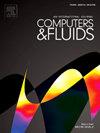Direct numerical simulations of two-dimensional channel flow with a gap deformity and slip wall
IF 2.5
3区 工程技术
Q3 COMPUTER SCIENCE, INTERDISCIPLINARY APPLICATIONS
引用次数: 0
Abstract
The effect of surface slip on the dynamics of flow separation induced by a Gaussian-shaped gap deformity in a two-dimensional channel was numerically investigated for Reynolds numbers . Two gap deformations, denoted wide and narrow, were modelled with dimensions sufficient to generate localised pockets of reversed flow when the channel walls were fully no-slip. The wide gap induces a more intense region of separated flow than the narrow gap but less than that exhibited by similar-sized bumps in a channel (Ceccacci et al., 2022). In addition, the size and magnitude of the separation bubble within each gap deformity plateaued for Reynolds numbers . Surface slip with slip length, , was modelled via a Navier-slip boundary condition. Applying the slip condition to the gap concavity reduces the magnitude and thickness of the separation bubble within the deformation and, for a slip length , eliminates separated flow for both gap configurations, which is less than the requirements for the bump configuration (Ceccacci et al., 2022). Moreover, limiting slip to the gap region, achieved the same flow separation control, as that realised by applying slip to the entire wall.

具有间隙变形和滑移壁的二维通道流动的直接数值模拟
在雷诺数Re∈[100,6000]的条件下,研究了表面滑移对二维通道中高斯形间隙畸形引起的流动分离动力学的影响。两种间隙变形,分别表示为宽和窄,其尺寸足以在沟道壁完全无滑移时产生局部的反向流动口袋。宽的间隙比窄的间隙诱导出更强烈的分离流区域,但比通道中类似大小的凸起所表现出的流区域要小(Ceccacci et al., 2022)。此外,在雷诺数为Re>;3000时,各间隙畸形内分离泡的大小和大小趋于稳定。采用Navier-slip边界条件对具有滑移长度λ的表面滑移进行了建模。将滑移条件应用于间隙凹度可以减小变形中分离泡的大小和厚度,并且对于滑移长度λ≈0.1,可以消除两种间隙配置中的分离流,这比凹凸配置的要求要低(Ceccacci et al., 2022)。此外,将滑移限制在间隙区域,实现了与在整个壁面施加滑移相同的流动分离控制。
本文章由计算机程序翻译,如有差异,请以英文原文为准。
求助全文
约1分钟内获得全文
求助全文
来源期刊

Computers & Fluids
物理-计算机:跨学科应用
CiteScore
5.30
自引率
7.10%
发文量
242
审稿时长
10.8 months
期刊介绍:
Computers & Fluids is multidisciplinary. The term ''fluid'' is interpreted in the broadest sense. Hydro- and aerodynamics, high-speed and physical gas dynamics, turbulence and flow stability, multiphase flow, rheology, tribology and fluid-structure interaction are all of interest, provided that computer technique plays a significant role in the associated studies or design methodology.
 求助内容:
求助内容: 应助结果提醒方式:
应助结果提醒方式:


